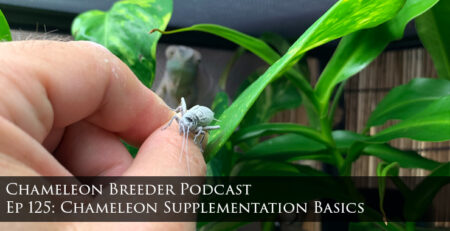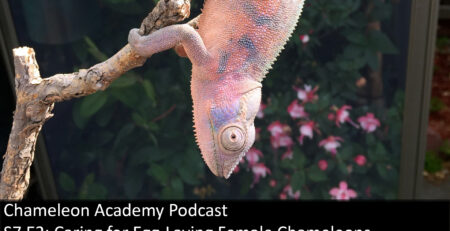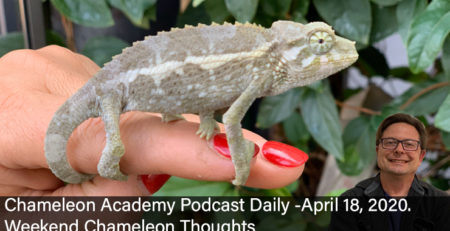Ep 203: Considerations when getting a Veiled Chameleon
Listen Here!
The most common chameleon to be kept is probably the veiled chameleon. But it is one of the most impressive of chameleons. Today I talk about what you should consider when considering a Veiled Chameleon.
Considering how wide spread veiled chameleons are one might think there isn’t much to think about when getting one. And, that is why so many people have trouble with Veiled Chameleons! So, this episode is going to parse apart the situation. I would love for people to be able to start off right with this incredible chameleon.
Link Resources
The following links will help you research Veiled Chameleons:
Chameleon Academy Veiled Chameleon Profile
Ep 107: Keeping Chameleons Together (learn why cohabitation doesn’t work!)
Chameleon Academy YouTube Channel
Transcript (more or less)
Introduction
To start off with, finding a Veiled Chameleon won’t be an issue It is the most prolific chameleon to the point where vendors at reptile shows who have no business offering chameleons can purchase an aquarium full to sell over the weekend. Pet stores often have them and now that they are well established in Florida, wild caught individuals are available. All of these are of equal pet potential. They originate from a country called Yemen in the middle east, but we have not seen new bloodlines for many years due to armed conflict in the region. Thus what we have in captivity has been from a limited number of bloodlines. The specimens that have populated areas in Florida are from this genetic bottleneck, but do have natural selection. The genetics may be strained, but this keeps them from being weak. All in all, I would love for new bloodlines to be made available and I will be first in line when that happens.
Price Considerations
The big issue with Veiled Chameleons is the price. The problem is with how low it is. What this means is that the only way to make money selling Veiled Chameleons is to cut your care of them to the bare minimum and rush them out the door as soon as possible. The number of veiled chameleons that grow to adult size under these conditions is a testament to their hardiness. But when you are looking for a veiled keep in mind that the cheaper the price, the rougher the life your baby has had.
Unfortunately, the wide availability of cheap veiled chameleons has made it difficult for serious breeders to give this species the attention they deserve. This is a case where the chameleon community has shot itself in the foot by price shopping chameleons. If we insist on paying corner cutting prices because that is what the meat market companies offer then we will remove the option for quality chameleons from reputable breeders. Occasionally, a reputable breeder will offer veiled chameleons as a passion project. If you are lucky enough to run across this opportunity, jump. Do not hesitate. Do not squabble about the price. Believe me, they could charge twice what the large companies do and they are still lucky to break even. This is because it takes time, space, and money to raise them up responsibly. But what you are getting is a superior quality chameleon. Both the mother and the baby were given the special attention that comes with being part of a reputable breeder’s program. And, yes, this does take some effort on your part. You have to be able to research the breeder to make sure they are reputable.
Just because the veiled chameleon is available to casual chameleon people, don’t let that dissuade you from being a serious chameleon herpetoculturist with the species. There are others like you and we all need to realize we are not islands.
Morphs
Now the subject of morphs. The only reliable color morph I know of is, the Translucent or pied. This is where there are varying levels of white and pink blotches. If this is to your liking then getting a baby translucent will likely get you what you are expecting. There are many other morphs advertised like sunburst or lemon or high blue or high yellow or any number of creative names. It is more murky as to whether these are truly morphs you can count on. While some people say they got the color they were expecting, others do not. What I can personally say is that if there were established morphs of Veiled Chameleons that were true to color, I would expect that there would be an industry developed like we see with panther chameleons and a network of breeders specializing in certain morphs. We do not. Variations in color obviously happens. But it isn’t obvious to me that there are reliable true-to-color morph lines. I welcome the proof that they do exist and I would happily report that here.
Caging
The next consideration is the cage you buy with your Veiled Chameleon. We have an epidemic of ZooMed Chameleon Kits being sold with pet store chameleons. As enticing as the marketing and box text, and what the pet store employee says, the ZooMed Chameleon Kit is not acceptable for a Veiled Chameleon. Followers of this podcast will recall an episode I did previously where I said that the kit would work for small chameleons, including young Veiled Chameleons. Yes, in the academic sense it is true. But practically speaking your veiled chameleon will grow so fast that even if you did get it when it was small enough to live in the 16x16x30 cage included, it would out grown the cage so quickly it isn’t even worth getting it as a temporary cage. If you listen to those podcasts, my entire reason for doing those was to educate people with the kit as to how to create a stop-gap measure until they could get an appropriate cage set-up.
No matter what size or age your veiled chameleon, get the adult size cage and set it up as you would an adult. Your baby will flourish under those conditions. Once again, people selling cheap chameleons are conditioned to sell cheap equipment because the majority of consumers will not want to pay more for the equipment than they did the chameleon. It is a completely ridiculous standard. Very much like people refusing to pay more in shipping than they do the product. All these things are completely independent, but, in our minds, we base the value of the transaction by the piece which we deem the focus. Once again, if you are getting a cheap chameleon, do not let that devalue its life. Put your savings in equipment. Get the proper equipment as if the chameleon cost you $500.
Once again, people selling veiled chameleons are conditioned to offer you cheap and inadequate equipment because that is the kind of customer they are used to dealing with. Break that mold. You have a 7 to 10 or even more relationship with your chameleon. Treat the entire relationship with respect and your chameleon will thrive.
The Cheap Mindset
So, if the cheap mind set is what the reptile show vendors have for veiled chameleons, what kind of care do you think they got? Just look at the aquarium with wood chips on the bottom and two sticks thrown in for 30 veiled chameleons to crawl all over each other. This is pretty disgusting. The best option is to pass this up and do not patronize that business. If you have to choose one out of that mass of green bodies then pick the one most active. Everyone of them is in a state of high stress and adrenaline. The ones sitting still or with their eyes closed have used up all their energy. It is best to pick one that is still showing it has fight in it. And, if my Hunger Games description takes the fun out of it, then I am glad I have been able to communicate the situation they are in. These are animals that need their own space.
Picking a Baby
And to address the reason why people pick the calm ones. I know, you want one that will be passive and friendly. The bottom line is that is not what a chameleon is. You may get a chameleon that is not fearful of humans. Go ahead and stick your hand in the cage and see if any come towards you instead of running away from you. Select that one. But do not take the behavior of not running away from you as a sign they are friendly. They are likely at the end of their stress rope and have given up. This is not the same as friendly.
Now, I am not saying that you picking one that doesn’t run means they will die on you. While they could and not running is a bad sign, these chameleons often bounce back once they are in proper husbandry conditions. Of course, some just continue their crash. It all depends on the individual. To be fair, Veiled Chameleons are much more likely to be able to recover than, say, a Jackson’s Chameleon, but still, make wise decisions in your selection process.
The fact that people inexperienced with chameleons are able to sell veiled chameleons greatly increases the chances that they will try and sell you a pair or two females or two or more and tell you they can live together. This is incorrect. The number of chameleons you can come home with has to match the number of cages you come home with. Don’t let anyone convince you otherwise. Male/female…two females…bonded brothers…a pair that has grown up together….no. If you want to dive into the details of cohabitation I have a podcast for that. I’ll link it in the show notes. But, spoiler alert, even though it explains all the reasons and details the end result is still, one chameleon per cage.
If you decide on a juvenile it is time to strap in your seat belt and get ready for a ride. Veiled Chameleons grow very quickly and can show mature colors at 4 ½ months. Your females can be laying eggs at six months. It is a good thing to feed your growing veiled chameleons as much food as possible, but to pull back when they are full grown. Obesity is a huge problem with Veiled Chameleons because they don’t have a stop signal when it comes to eating. – especially if they are kept hot like may caresheets direct. So, in addition to learning about general chameleon care, you need to get familiar with the special conditions surrounding Veiled Chameleons.
MBD
All chameleons are susceptible to Metabolic Bone Disease. This is where animals do not get enough vitamin D3 and cannot absorb calcium. Bones are brittle and weak. So why do we see it in Veiled Chameleons the most? Well, it is the combination of 1) the chameleon growing so fast (so there is little time to figure out something is wrong) and 2) The veiled chameleon being sold to people with little to no experience and selling them cheap and inadequate equipment to go along with inadequate information. So, a bad start with a race to maturity that does not allow for a lot of time to integrate with the community and learn that something needs to change in the husbandry. The solution is a simple application of sufficient UVB light. Even if they are told this, how could they know that the UVB light they came home with in the Chameleon Kit is entirely inadequate? The lack of good information and the expense of proper equipment is a potent cocktail that spells trouble for newcomers getting their first chameleon. This is why listening to this episode and, at least knowing what you need to know, is so important at the beginning. And I wish I could get it in the hands of every new chameleon owner.
Special Considerations for a Veiled Chameleon Female
You can sex Veiled Chameleons from birth by the spur on the back of their back ankles so you have a choice between the two. Either makes a good pet, but the females are geared to laying eggs. They have to in order to make sure the next generation is safely in eggs under ground before the dry season comes. This genetic drive combined with the less than ideal husbandry given to them turns them into egg making machines. The excessive diet and heat supercharges their body into gaining unhealthy weight and activating massive amounts of eggs to be developed. And this can happen even if she is not mated. It is so prevalent, that some veterinarians are suggesting proactive spaying to avoid the stress of egg laying. While it does fix the problem it does not eliminate the cause of the problem. The cause is improper husbandry. And the reason why it is so difficult for the community to change their ways is because the unhealthy part of this makes them grow bigger and faster.
There needs to be an education that there is a good “big” and a bad “big”. Veiled Chameleons that are large in healthy proportions are no problem. In other words, they are long. Veiled chameleons that start having fat bulging out of the casques and large fat pads that end up restricting the oviducts are not only not healthy, but they can be deadly. If you have heard of egg binding, that is a condition that can be caused by overfeeding and overheating. Too many eggs and fat pads that are too big can easily equal your female chameleon’s death. This is a difficult thing to educate on because bigger and egg production have traditionally been markers of health in our community.
So you can see why it is so hard to get the community to change course from the advice they have been giving all this time. It is a lot easier to prove that overfeeding and over heating creates big chameleons and that high egg production is a sign of extra good husbandry than it is to put numbers to reduction in lifespan. So this will be a long road.
Add this this that we are still figuring out the right numbers to tell people. This revelation is relatively new so only the people on the cutting edge of chameleon husbandry are working with it. This is ambient temperatures in the mid 70s with a basking temperature in the low 80s and a couple of food items every other day for adults. But we are showing promising results as far as decreased egg production and decreased production of infertile clutches.
To be fair, this is something we need to proceed with caution. Cold and underfed chameleons will be stunted so, like everything, it is possible to go too far. So, this change isn’t something to be done without a firm respect for consequences. But we must go forward considering the health crisis we are experiencing in female veiled chameleons. It is so normalized that most chameleon keepers do not recognize obesity.
This particular episode was meant to help you make decisions in how to obtain a Veiled Chameleon. I’ll link to a flight of episodes in the show notes where you can dig deeper into all the episodes on husbandry which is part of the preparations that are appropriate to do before bringing one home.
Veiled Chameleon Mis-information
The last thing I need to prepare you for is that there is an unfortunate amount of misinformation about Veiled Chameleon natural history. It isn’t surprising considering that their native Yemen has been in civil war and you can’t just go visit their homeland. In fact, it took me years of searching before I finally found eye witnesses that I could interview on this podcast. And once I did, I found that much too many of my previous assumptions were wrong. Amazing what happens when you step outside the echo chamber of our assumptions and go to the source. I am going to list the major revelations, but in the show notes I will link to the interviews themselves so you can hear for yourself. Understand that this information is only slowly making its way through the community.
- Veiled Chameleons are not from hard arid lands. They come from high altitude mountain valleys called Wadis that are lush with vegetation during the wet season and get clouds of fog rolling into the wadis at night. The idea of hot and arid comes from photos and videos taken during the dry season when nature is killing them off. The populations literally crashes every year at the beginning of the dry season and is reborn when eggs hatch at the beginning of the wet season the next year. So, now you know why they have to grow as fast as they do.
- Veiled Chameleons are not a high UVB species. Like most chameleons, they get warmed up in the morning and hide from the hot afternoon sun. Veiled chameleons are healthy at a UV Index of 3 and there has been, to date, no evidence they need higher UVB.
- Veiled chameleons do not need high heat. If you want to check their weather conditions yourself check the weather stations for Ibb, Yemen. You will find a standard montane environmental condition on par with what you would expect for a Jackson’s Chameleon. The difference is that Jackson’s will die at higher heat and Veiled chameleon will just get bigger and unhealthy. We humans like bigger so we have made a negative a false positive.
This episode is not about diving into each of these issues. This is more of a warning that there is more misinformation about this species than there is for other species. So, you are lucky that you can start off on the right foot. When in doubt, listen to the people who have been there, not the ones who have just memorized internet talking points. It took me years to find eye witness sources to get my information straight. Take advantage of that effort and start off right to begin with. And don’t argue with people who haven’t yet updated their information. It will be a waste of your time.
I have integrated all the latest husbandry information on the Chameleon Academy care sheets and you are welcome to base your start there. A link in the show notes goes to a full description of husbandry.
And, this all gets you started on the right foot. Veiled Chameleons are great chameleons. The colors and casque are impressive. The personality is usually shy and defensive, but if we are getting a chameleon with the intention of letting him be a chameleon this shouldn’t be an issue. If you need to hold your chameleon to be happy then a chameleon is not the best choice. I have enjoyed working with Veiled Chameleons over these may years and have dedicated much time on the podcast to support the proper care of the species. Everything you need to have a wonderful, long term experience with your veiled chameleon is available to you. Your job is to make sure you get the best little guy or girl to start off with.












